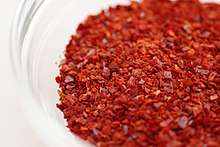Korean chili pepper
| Korean chili pepper | |
|---|---|
 Green chili peppers | |
| Species | Capsicum annuum |
| Origin | Korea |
| Heat |
|
| Scoville scale | 1,500 SHU |
Korean chili peppers or Korean hot peppers, also known as Korean red,[1] Korean dark green,[2] or Korean long green[3] peppers according to color (ripening stages), are medium-sized chili peppers of the species Capsicum annuum. The chili pepper is long, slim and mild. Green (unripe) chili peppers measure around 1,500 Scoville heat units.[4]
Names
In Korean, the chili peppers are most often called gochu (고추), which means "chili pepper".[5] Green ones are called put-gochu (풋고추),[6] and red ones are called hong-gochu (홍고추).
Culinary use
Gochugaru

Gochugaru, also known as Korean chili powder,[7][8] is chili powder or flakes used in Korean cuisine.[9] The name "gochugaru" derived from Korean gochu-garu (고춧가루; gochutgaru), where gochu (고추) means "chili pepper" and garu (가루) means "powder".[10][5][11] In English, gochugaru usually refers to the seedless, Korean variety of chili powder. It is vibrant red in color, and texture and heat level may vary from fine powder to flakes, and from mildly hot to very hot.[12][13] Traditionally made from sun-dried Korean red chili peppers (called taeyang-cho), gochugaru has a complex flavor profile with spicy, sweet, and slightly smoky tastes.[12] Gochugaru made from Cheongyang chili peppers are finer and hotter.
Gallery
 Red (ripe) chili peppers
Red (ripe) chili peppers Green (unripe) chili peppers
Green (unripe) chili peppers Harvested green chili peppers
Harvested green chili peppers Red chili peppers tied with saekki (straw ropes)
Red chili peppers tied with saekki (straw ropes) Dried red chili peppers
Dried red chili peppers
See also
References
- ↑ Kim, Suna; Park, Jaebok; Hwang, In Kyeong (January 2004). "Composition of Main Carotenoids in Korean Red Pepper (Capsicum annuum, L) and Changes of Pigment Stability During the Drying and Storage Process". Journal of Food Science. 69 (1): FCT39–FCT44. doi:10.1111/j.1365-2621.2004.tb17853.x. Retrieved 10 July 2018.
- ↑ Newcomb, Karen (2015). The Postage Stamp Vegetable Garden: Grow Tons of Organic Vegetables in Tiny Spaces and Containers. New York: Ten Speed Press. p. 133. ISBN 978-1-60774-683-6. Retrieved 10 July 2018.
- ↑ Reddy, K. Madhavi; Shivashankara, K. S.; Geetha, G. A.; Pavithra, K. C. (2016). "Capsicum (Hot Pepper and Bell Pepper)". In Rao, N. K. Srinivasa; Shivashankara, K. S.; Laxman, R. H. Abiotic Stress Physiology of Horticultural Crops. New Delhi: Springer. doi:10.1007/978-81-322-2725-0_9. ISBN 978-81-322-2723-6. Retrieved 10 July 2018.
- ↑ Baek, Sangkyung (16 March 2017). "[Consumer Journal] 辛맛에 빠진 대한민국". Maeil Business Newspaper (in Korean). Retrieved 10 July 2018.
- 1 2 "gochu" 고추. Korean–English Learners' Dictionary. National Institute of Korean Language. Retrieved 27 July 2017.
- ↑ "put-gochu" 풋고추. Korean–English Learners' Dictionary. National Institute of Korean Language. Retrieved 28 August 2018.
- ↑ Collins, Glenn (4 December 2012). "Sandwiches for Sandy Relief". The New York Times. Retrieved 27 July 2017.
- ↑ Khaleeli, Homa (22 October 2013). "A global guide to pickles". The Guardian. Retrieved 27 July 2017.
- ↑ Lamuye, Adebola (7 July 2017). "5 must-try Korean dishes". Evening Standard. Retrieved 27 July 2017.
- ↑ "Gochutgaru" 고춧가루. Korean-English Learners' Dictionary. National Institute of Korean Language. Retrieved 27 July 2017.
- ↑ "Garu" 가루. Korean-English Learners' Dictionary. National Institute of Korean Language. Retrieved 27 July 2017.
- 1 2 Smith, Kat (8 March 2017). "Gochugaru: The Hot, Sweet, Smoky Red Pepper Powder That is the Taste Behind Many Korean Foods". One Green Planet. Retrieved 28 July 2017.
- ↑ Ried, Adam (17 February 2017). "Recipes: Korean soups with choose-your-adventure spiciness". The Boston Globe. Retrieved 27 July 2017.